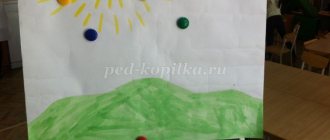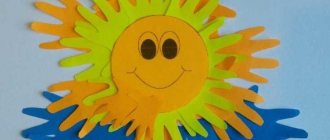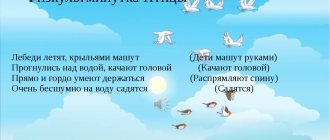Summary of a lesson on appliqué in the senior group “Autumn Flowers”
Tasks:
Educational:
— Introduce children to the method of symmetrical cutting from paper folded several times (taking into account the characteristics of the inflorescences);
— Teach how to compose a composition on the plane of a sheet (a sign of beauty can be found in the combination of a dark background and a light bouquet and a light background and a dark bouquet);
— Activate the dictionary;
- To form a generalized idea of autumn flowers - asters, dahlias, calendulas, chrysanthemums.
Educational:
— Develop a sense of color, a sense of composition;
— Develop attention, memory, logical thinking, imagination of children;
— Develop interest in completing tasks and creative activity.
Educational:
— Cultivate accuracy in working with scissors and paper;
— To cultivate a caring and aesthetic attitude towards nature, a sensitive attitude to the beauty of autumn flowers.
Methods and techniques: verbal, practical.
Materials and equipment: Reproductions from paintings by famous artists, postcards with images of autumn bouquets, bouquets of fresh flowers, background paper - dark, light, square paper blanks for flowers (also light and dark), scissors, glue, napkins.
Preliminary work: Examining autumn flowers in flower beds; search for contrasting combinations (plants, objects) in the surrounding world; reading fiction about flowers; viewing reproductions, pictures, postcards depicting still lifes with flowers.
Progress:
1. - The Sorceress Autumn gave us many gifts - these are mushrooms, fruits, vegetables, and berries; she decorated the trees with rich clothes and grew beautiful flowers.
— What autumn flowers do you know?
— Look at the bouquets in vases. What does an aster flower look like? Dahlia? Please note that these flowers have many petals and are lush.
- And if we place all the light asters and calendulas on the table against the background of a light wall, and dark dahlias, gladioli, chrysanthemums against the background of a dark curtain, what will happen? (not bright, the background blends in with the colors)
- Let's swap our bouquets - what happened? Why?
- Now we will also try to create our own unique bouquets, we will be magicians, magicians. Let's make light flowers on a dark background, and dark ones on a light background.
Phys. just a minute
2. There are materials for work on the table; children independently select the ones they need.
— To get a beautiful aster or chrysanthemum, you need to fold the leaf diagonally in half 3 times, holding it by the blind corner of the fold, make several cuts on the open side, cutting out the pointed petals of the flower, and unfold it. (Show.)
— For dahlia and calendula petals, you need to follow the same steps, only cut out the rounded petals. (show)
— In order for the flower to be lush, several cut blanks are needed. The tips of the petals can be bent using a pencil or scissors. Next, cut out the stems and leaves.
- After finishing working with scissors, we try to create a composition on the background sheet - make the bouquets the way you like.
- Apply glue only to the middle of the workpiece, assemble it - you get three-dimensional flower heads. (Show.)
Children's work. Individual assistance.
3. Lay out the work on the table.
— Dear wizards, do you think we succeeded in turning paper into luxurious autumn flowers?
— Did you get the right combination of background and bouquet?
— Which bouquets do you like best? Why?
- Let's collect all the compositions and arrange an exhibition for parents, so that they can also admire your magical bouquets of autumn flowers.
Flower meadow
The fabric applique attracts with its brightness. It can become a wonderful decoration for clothing, interior items, or an original souvenir.
The master class presented in the article will tell beginning needlewomen how to easily make an applique “flowers from fabric” with their own hands.
You need to prepare for work:
- sketch paper;
- needles, scissors, threads;
- glue;
- fabric (it is advisable to use different types of fabric).
Stages of work:
- Draw the petals (you can print ready-made templates or use flower-themed coloring books).
- Carefully cut out the blanks.
- Place the prepared samples on a cloth and secure with needles. Then draw the contours of the petals and cut them out, not forgetting to make room for hemming the edges of the parts.
- The edges need to be folded and ironed carefully. Make up a composition at your own discretion, first secure each element with needles, and then baste (for ease of work at the next stage).
- All parts are carefully sewn to the product using an invisible seam.
These appliqués can be used to decorate sofa cushions, summer hats, and dresses. The panel will look beautiful. To do this, take thick cardboard, stick green velvet paper on top and “scatter” bright flowers throughout the space and glue them.
The picture can be inserted into a frame under glass. An amazing gift, the price of which is the love of creativity.
Family tree making technology
If you want to try something new in your work, then I suggest you do some applique work in the form of a family tree. In this case, it is advisable to make the crown of the tree whole; voluminous leaves are not suitable here. In this photo they look very sloppy.
What will happen on the crown depends on your imagination. You can stick apples on which children will write members of their family (suitable for a preparatory group) or flowers. You can also ask parents in advance to bring photographs of family members in the form of small circles. Such a craft can even take pride of place in the living room and become a family heirloom. There are a lot of options, choose depending on the age of your students.
Volumetric fabric flowers
An applique of such flowers diversifies interior items. A minimum of components and tools are required. Many housewives have collected multi-colored pieces of various fabrics. For this craft it is better to use cotton. There will also be buttons.
Need to prepare
- tissue components;
- flat buttons of various colors in two sizes;
- handicraft tools;
- thin cardboard.
You can get started:
- Make a template out of cardboard - a circle. It is advisable to prepare blanks of different diameters.
- Transfer the stencils to the fabric. Trace the silhouettes (not forgetting the seam allowances), cut them out, turn the edges in, sew with a regular seam, and iron.
- Tighten the thread to form a bag.
- First sew a button of a larger diameter into the middle of the product, and sew a smaller button on top.
- Attach the resulting three-dimensional flower to the intended base in different ways (sew or glue).
- Similarly, make the required number of multi-colored flowers.
Hand-made appliqué of pressed dried flowers is used in room decoration along with purchased designer items and accessories.
Today on the decor market you can often find paintings in the oshiban style from various manufacturers. It's worth trying to create them yourself.
Amazing paintings
Flat applique is the simplest version of creating an original panel of dried flowers. All parts of a dry plant can be used: shoots of various curves, leaves, inflorescences, seeds.
The base for the applique is often covered with fabric or painted with watercolors.
Thick cardboard quite often acts as a similar base for small crafts, since it has excellent adhesion to any glue and is well processed with various paints.
Often, burlap is used at the base of the picture, which is used to cover the canvas. Many craftsmen use this material based on its environmental friendliness. Such applications are suitable for beginners who love floral art.
Volumetric product
It will require white sheets, glue, colored paper (thick) or cardboard, and a glue stick. We will decorate with a purple felt-tip pen.
Let's cut out 7 squares.
Fold each square diagonally, then 2 more times diagonally.
This results in a triangular element.
We mark it and cut it.
This is what the expanded template looks like.
We paint them with a felt-tip pen, leaving 2 unpainted ones on each flower.
We cut off one of them.
Glue the petals together to make the flowers three-dimensional. Additionally, we press through all the fold lines again.
We assemble the workpiece. We place one with the sharp corners up. We glue 2 more blanks onto the side petals on each side. New elements are marked in red, and the lower part is marked in green. Next in the master class we mark with red dots those on which we glue new parts.
When gluing is completed, we cut leaves from double-sided paper - 4 large and 4 small.
Glue them onto the workpiece as shown in the photo. We turn over the remaining 4 molds and fix them on the reverse side. For clarity, we took sheets with one white side. The leaves should face each other with their colored side (so that when they open, everything looks right).
Glue it onto cardboard or thick paper folded in half. We fix only the outer petals (marked with a red dot).
Wait for the work to dry. It turns out to be a beautiful three-dimensional craft.
What materials can be used for creativity?
Real and artificial flowers accompany a person throughout his life, decorating it and bringing notes of joy and comfort into it. A simple craft or three-dimensional composition made using the appliqué technique will become a real masterpiece if a piece of the soul of the person who made it is put into it.
Every child can cope with a simple task, and an experienced craftsman will not need much time to realize the most sophisticated idea and repeat an unusual design, provided that the materials are chosen correctly.








